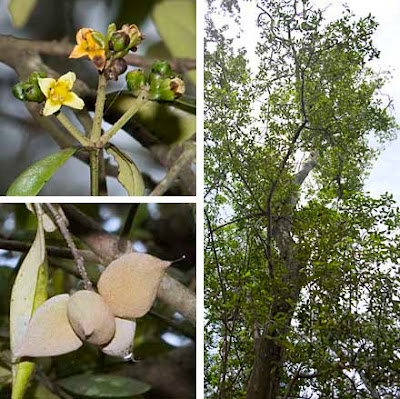On these trips, I tried to GPS mark the big trees and the rare trees. It was overwhelming!
The mangrove forest at Mandi is huge! I did it in sections (more or less). Today, on the fourth day of visiting, I managed (finally) to get to the stream at the northern most end of the mangroves. I believe it is called Sungei Fatimah. And there's still more mangroves on the other side which I haven't seen!
Besides soft squishy mud, there are sand bars on some of the outer edges of the mangroves. But the extensive back mangroves are what got me excited. Because this is where all kinds of rarey trees lurk!
I was delighted to come across a tall Gedabu (Sonneratia ovata)! It's possibly the tallest one I've seen so far. It was furiously flowering, but I couldn't see any fruits. This tree is listed as Critically Endangered.
And another Gedabu which was smaller. I couldn't see any flowers.
A wild seashore spider lily (Crinum asiaticum) grows near a humungous Jejawi tree (Ficus microcarpa). Although the lily is widely grown in our parks, it is listed as Critically Endangered. And indeed, I very seldom come across wild ones.
I came across a very large patch of the Critically Endangered Kalak kambing (Finalysonia obovata) sprawling over a sunny open area in the midst of the trees. Some were blooming! I also saw several other smaller clumps, sprawling over trees dead and alive.
What a nice surprise to come across two Ipil (Intsia bijuga) trees. One was small, the other was quite tall. I saw some pods but didn't see any flowers. This tree is listed as Critically Endangered.
I saw many bushes of the Critically Endangered Limau Lelang (Merope angulata) and some of them were blooming and fruiting!
There is a forest of Endangered Teruntum (Lumnitzera sp.) trees at Mandai! I think most of them are Teruntum putih (Lumnitzera racemosa). There are a few large trees, lots of skinny but tall ones, and many many small bushes everywhere near the bigger mother plants.
I saw lots and lots of the Endangered Dungun (Heritiera littoralis) with some very tall specimens, though most were small trees or just bushes. Many of them were blooming!
There are several large clumps of very happy looking Dungun air (Brownlowia tersa). This plant is listed as Endangered, and many of the clumps were flowering and fruiting.
I saw several clusters of very tall Nipah palms (Nypa fruticans). Many of them were blooming and fruiting. This plant is listed as Vulnerable.
Of course, I saw lots and lots of the Critically Endangered Beccari's seagrass (Halophila beccarii), not only on the seaward side of the shore, but also in the back mangroves and upstream of small mangrove streams.
After putting in my points for some of the rare plants (red=Critically Endangered, yellow=Endangered, light blue=Vulnerable), I realise all the super rare plants that I saw are found in the back mangroves. And the rarest are furthest upstream.
There are many huge trees at Mandai! I've decided to mark trees with a girth of 2m or more. Kind of a mistake, as there were so many that I got tired marking them down. Most of the huge trees I saw were Api-api bulu (Avicennia rumphiana).
Among the many common trees that have grown huge are several Api-api putih (Avicennia alba).
Also some Api-api ludat (Avicennia officinalis).
Here's my points of the big trees that I saw. They were nearly everywhere!
I didn't see many Nyireh bunga (Xylocarpus granatum). Just a few, but one of them was very large and flowering.
I saw one small Misi or Sea gutta (Pouteria obovata).
There are all kinds of epiphytes growing on the trees. Like these Dragon scales (Drymoglossum piloselloides) a kind of creeping fern. The fertile leaves that bear spores are long and narrow, edged with brown spores on the underside. These tough little ferns pave the way for less hardy ferns to settle on the dry trunks and branches of trees by creating more conducive micro-habitats.
I saw this palm growing just where the mangroves end. I'm not sure if it's a common palm and will be lame and hope someone kindly helps me out here
 |
| Mystery palm. |
Alas, there are some very large trash on the shore. And trees have grown over some of them.
I probably missed a lot of plants as I got easily distracted, don't really have good eyesight, and often got lost. So I'm looking forward to more trips with others who have better knowledge and eyesight, to learn more about this fascinating mangrove forest.
In the process of looking up at trees, I missed the fauna forest! But I did accidentally see some animals too. These are in the next post.
























